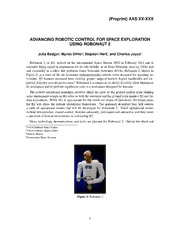
NASA Technical Reports Server (NTRS) 20120002793: Advancing Robotic Control for Space Exploration Using Robonaut 2 PDF
Preview NASA Technical Reports Server (NTRS) 20120002793: Advancing Robotic Control for Space Exploration Using Robonaut 2
(Preprint) AAS XX-XXX ADVANCING ROBOTIC CONTROL FOR SPACE EXPLORATION USING ROBONAUT 2 Julia Badger∗, Myron Diftler†, Stephen Hart‡, and Charles Joyce§ Robonaut 2, or R2, arrived on the International Space Station (ISS) in February 2011 and is currently being tested in preparation for its role initially as an Intra-Vehicular Activity (IVA) tool and eventually as a robot that performs Extra-Vehicular Activities (EVA). Robonaut 2, shown in Figure 1, is a state of the art dexterous anthropomorphic robotic torso designed for assisting as- tronauts. R2 features increased force sensing, greater range of motion, higher bandwidth, and im- proveddexterityoveritspredecessor.1 Robonaut2isuniqueinitsabilitytosafelyallowhumansin itsworkspaceandtoperformsignificanttasksinaworkspacedesignedforhumans. The current operational paradigm involves either the crew or the ground control team running semi-autonomousscriptsontherobotasboththeastronautandthegroundteammonitorR2andthe data it produces. While this is appropriate for the check-out phase of operations, the future plans for R2 will stress the current operational framework. The approach described here will outline a suite of operational modes that will be developed for Robonaut 2. These operational modes includeteleoperation,sharedcontrol,directedautonomy,andsupervisedautonomy,andtheycover aspectrumofhumaninvolvementincontrollingR2. Many technology demonstrations and tasks are planned for Robonaut 2. During the check-out ∗NASA-JohnsonSpaceCenter †NASA-JohnsonSpaceCenter ‡GeneralMotors §OceaneeringSpaceSystems Figure1: Robonaut2 1 Figure2: ReconfigurabletaskboardforR2check-outoperations phase, R2 will be tested using a specially-designed task board that was sent to the ISS along with the robot.2 The task board, shown in Figure 2, consists of many common manipulation tasks per- formedbythecrewbothinsideandoutsideoftheISS,suchaspushingbuttons,actuatingswitches and valves, and handling fasteners. After the task board testing has been completed, R2 will be integrated with legs and a battery backpack for mobility. Suggested tasks for IVA include gen- eralcleaningandvacuuming,toolsandpartsinventory,toolcalibration,equipmentrelocation,food preparation and clean up, general inspection, and air and water testing. Robonaut 2 is expected to helponEVAbysettingupandtearingdownworkstations. ByhavingR2dothisworkinsupportof theEVA,theastronautswillbeabletospendlesstimeonsimplemaintenancetasksandhavemore timetospendonimportantandcomplexactivities. The breadth of tasks that R2 is slated to perform drives the spectrum of control modes to be implemented. ManyoftheIVAtasksmentionedarechorescurrentlyperformedbyastronauts. For many of these tasks, such as cleaning or inventory, it is important that R2 can complete its job with minimal crew involvement. If R2 can perform these tasks autonomously and supervised only by the ground control team, precious on-orbit time can be saved, allowing astronauts to complete moreimportantscientificactivities. ForEVAtasks,R2willlikelybeoperatedbyacombinationof modes. ThegroundwilldirectthetranslationoftherobotalongtheoutsideoftheISSwhilethecrew memberswouldeitherteleoperateR2orcloselymonitoranddirectsemi-autonomousfunctionality to complete the more intricate tasks. Understanding how to distribute function, supervision, and autonomy in an environment where safety is paramount is an interesting and important challenge. Furthermore, learninghowtooperateR2inIVAandEVAwillapplydirectlytoroboticoperations duringlongdurationexplorationmissions. TechnologyadvancesincontrollingR2willtakeaprogressiveapproachalongthespectrumfrom constant supervision towards autonomy. After the check-out phase, one of the operational modes thatwillbeexploredisteleoperation. ThecrewwillteleoperateR2bydonningspecialequipment, includingavirtualrealityimmersionhelmet,asdepictedinFigure3. Thecrewmemberwillarticu- latecommandsto“thaw”and“freeze”therobot’shandsandarms. Thecrewmember’smovements will be sent to R2 as position commands. Shared control is another operational mode that will be used. The operator will have an interface that allows him or her to pick a path for the robot to follow, validate the path using simulation, then approve and monitor the movement. Simple com- mands, such as “open hand,” may be used by the operator. Operation over time delay is also a 2 Figure3: AstronautDonPettitteleoperatingR2 current research topic,3 and this will essentially allow shared control of R2 by ground controllers. However, since the robot will need extra autonomous functionality to work safely during the time delay,thissortofcontrolisreferredtohereasdirectedautonomy. The development of teleoperation, shared control, and directed autonomy will allow R2 to be- come extremely effective for EVA and some IVA tasks. However, a greater degree of autonomy is necessaryfortaskssuchastakinginventoryoftoolsorobjects. Forthissortofactivity,apotential operationalscenariocouldbeasfollows. First,anoperator(eithercreworground-based)checksout R2 and configures it for the inventory task. A ground operator will then monitor as R2 works. R2 will autonomously move through the specified lab or area, counting and logging the item or items it has been assigned to inventory. Whenever R2 has a question (i.e., “is this a rubber glove?” or “whereisthenexthandrail?”),thegroundcontrollerwillbeavailabletogiveinputtoR2. IfR2has amoreseriousproblem,suchasahardwareissuewithadraweroranissuewiththerobotitself,the groundoperatorwilltroubleshoottheproblem,andifnecessary,acrewmemberwouldbecalledin tosupportthetask. Manyadvanceswillbeneededforthisoperationalscenario,includingvisionprocessingforiden- tifyingthetoolorobjectbeinginventoried,mapdevelopmentforefficienttraversalofthespecified areaoftheISS,andintelligentplanningandlearningfunctionstoallowtherobottohandlecontin- gencies appropriately. Research efforts are currently underway in all these areas in preparation for operationsusingsupervisedautonomy. Finally, robotic assistants on long duration missions will likely need to be programmed to com- plete new tasks in situ. Allowing the ISS crew the ability to train R2 to accomplish new tasks is an important feature which will further demonstrate the utility of service robots on long duration missions. Inorderforthistobepossible, anewrobustsetofcorefunctionalitiesthatcanintegrate effectivelywithoneanothermustbeaddedtoR2’scontroltoolbox. In conclusion, Robonaut 2 will serve as an excellent platform for understanding how best to operate service robots in future exploration missions. As R2 moves along a spectrum of control fromdirectteleoperationtosupervisedautonomy,roboticstechnologywillbepushedtoprovidethe degreeofreliabilityandintelligenceneededtomakeroboticoperationseffectiveandefficient. The different tasks planned for Robonaut 2 are representative of what will be needed on long duration missions,andtheISSisanincredibletestbedonwhichtoconductthisresearch. 3 REFERENCES [1] M.A.Diftleretal.,“Robonaut2-thefirsthumanoidrobotinspace,”inProc.oftheIEEEInternational ConferenceonRoboticsandAutomation,2011. [2] M.A.Diftleretal.,“Robonaut2-initialactivitieson-boardtheISS,”inProc.ofIEEEAerospaceCon- ference,2012. [3] R. Burridge and K. Hambuchen, “Using prediction to enhance remote robot supervision across time delay,” inProc.oftheIEEE/RSJInternationalConferenceonIntelligentRobotsandSystems, pp.5628 –5634,Oct.2009. 4
